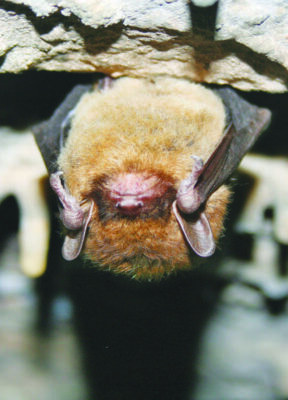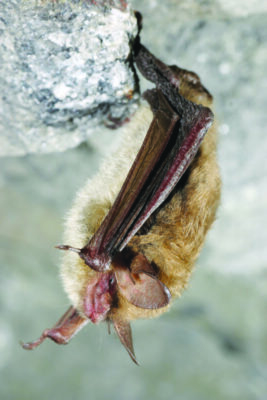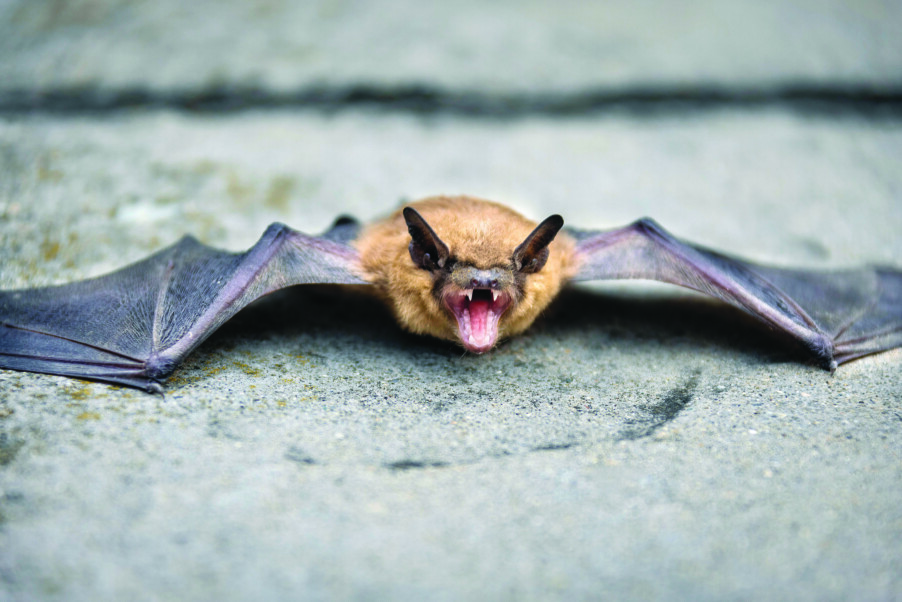The state of NH’s bat population and what people can do to help
Bat Week, an international celebration and week of awareness for bats, runs from Tuesday, Oct. 24 through Halloween. While bats are a standard of Halloween scene-setting, many species of bats spend this time of year through mid-April hibernating in caves and mines. There, they face a threat — a fungal disease called white-nose syndrome that has, in addition to habitat loss and fragmentation, nearly obliterated the bat population in New Hampshire.
Bats in peril
“I wouldn’t call any of our bat species common because they all have threats to their population that result in population decline over the last 15 years or so,” said Haley Andreozzi, a wildlife conservation state specialist with the University of New Hampshire Cooperative Extension. “We have eight species of bats in the state of New Hampshire and all of them are what we consider species of greatest conservation need, which means they’ve been identified in the state wildlife action plan as species that warrant special concern.”
Half of these species, the little brown bat, eastern-small footed bat, tricolored bat and the northern long-eared bat, are all state endangered, the last of which is also federally threatened. The other species in the state include the big brown bat, the hoary bat, the silver-haired bat and the eastern red bat.
According to Sandra Houghton, wildlife diversity biologist with the New Hampshire Fish and Game Department, maternity colonies begin to disperse and head to their winter locations in mid-to-late August. Andreozzi says that the hoary bat, eastern red bat and the silver hair bat head south while the rest hibernate in the New England area, mostly Vermont and New York, in caves and mines, where they face the threat of acquiring white-nose syndrome.
“White-nose syndrome was first found in New Hampshire in 2009 and it really has decimated bat populations in the state for those species that spend the winter hibernating in caves and mines,” Andreozzi said. “Their populations have seen declines of [around] 99 percent … in the last 14 years since the occurrence of white-nose syndrome in the state.”
The conditions that are ideal for this fungus to spread are the same that are ideal for bats to hibernate: damp, 40-degree cave environments. The white fungus can be on an affected bat’s ears, wings, tail or nose, and while the fungus itself doesn’t directly result in a bat’s death, it leads to abnormal behaviors that do.

“Bats are typically what we consider true hibernators; they’re really doing everything they can to expend very little to no energy in the winter months,” Andreozzi said. “They’re really kind of shutting down their bodies to make it through the winter so they don’t require any fuel, because their major food source, which is insects, isn’t available in winter. This fungus causes them to become more active and is really forcing them to use up fat stores that they otherwise really rely on to get through those winter months.”
Impacted bats will sometimes fly out of their hibernation sites into the cold to look for food and water and face the risk of freezing or starving to death.
As with many wildlife species, Andreozzi notes, habitat loss and fragmentation pose further threats to bat populations.
“As development and human population has increased, we’ve seen an increase in habitat loss and fragmentation that’s had negative consequences for those species and populations,” she said.
Bats in the ecosystem
Losing the bat population could have negative impacts ecologically and economically.
In tropical areas, bats are very important pollinators for flowering plants, according to Andreozzi. Here, in more northern parts, their primary role is different.
“They eat a ton of insects and here in New Hampshire bats are actually the greatest predator of night flying insects that we have, and that’s because they have extremely high energy,” she said. “It takes a ton of energy for them to fly and so they’re typically eating half their body weight every night in insects, but even more if they’re a female who’s nursing pups.”
According to the New Hampshire Fish and Game Department, this can equate to 1,500 mosquitoes per bat per night. They also feed on agricultural pests, providing a pest control service valued at $3.7 billion annually according to an analysis mentioned on the New Hampshire Fish and Game Department website.
One of the best things people can do to help bats combat the effects of white-nose, according to Andreozzi, is simply let them be and help maintain their habitat. Disturbing them during hibernation and rousing them can threaten their survival during the winter. During the summer, bats’ roosting sites vary depending on the species, eastern small-footed bats preferring hillside or cliffs and northern long-eared bats roosting in cracks in trees or crevices under tree bark. Others, like the big brown bat and the little brown bat, have adapted to using human structures.
“We encourage people to let bats exists where they have for centuries, which is in their barn or other outbuilding, so if someone has bats in their barn, shed or even their attic [if] it’s in a place where it’s not bothering them and there’s no human health concern,” Andreozzi said. “It’s really become an important, valuable bat habitat … and there is a way that bats and people can coexist if there’s no chance of direct contact with humans.”
If you meet a bat…
If you do come in contact with a bat, it’s important to take the right measures. While bats have a reputation for carrying rabies, they don’t carry rabies at a higher rate than any other mammal. Andreozzi says the issue with bat bites versus another animal, like a raccoon, is that their bites are so small you might not even notice you were bitten.
“Any case where a bat is found in a living space, like with a sleeping child [or] some other considerations, it needs to be treated as if the bat does have rabies regardless, and then you should get in touch with the department of health and human services through the state,” Andreozzi said.
If there is no chance of contact and you just wish to remove a bat from your house, she recommends turning off all the lights and opening a window and allowing the bat to fly out on its own. If that doesn’t work or the circumstances are more complicated, you can hire a licensed wildlife control professional for help.
Bat hospitality
Instead of sharing yours, there’s also the option of making bats a home of their own.
“People can install a bat house, which is basically an artificial roost structure,” Andreozzi said.
It’s not as simple as putting up a wooden box and hoping for the best, she says. There are specific features that make a bat house successful.
“You want them to be large, you want them to be dark in color, ideally facing south or southeast so they get really hot, because that’s what the bats are looking for,” Andreozzi said.
According to Bat Conservation International’s “The Bat House Builder’s Handbook,” the chambers of a bat house should be a minimum of 20 inches tall and 14 inches wide to be successful with at least one chamber. The bigger the house, and the more chambers it has, the better. While it’s important for the houses to be hot, ventilation slots are needed to prevent overheating when the average temperature in July is 85 degrees or higher. Having at least three chambers will likely be better at providing appropriate temperature ranges and will be more suitable for a larger number of bats and nursing colonies, according to the guide.
“You want them pretty high off the ground, typically more than 12 feet high or so,” Andreozzi said.
The guide says that bats are better able to find bat houses when they are mounted on poles or buildings as opposed to trees. This is also a more attractive location, as bat houses on trees will likely receive less sun and be more vulnerable to predation. Positioning them under an eave is a way to protect them from both predators and rain.
“With proper specifications and installation practices, those bat houses can be successful,” Andreozzi said. “They’re not always, but they do get occupied by bats pretty regularly when installed around the state.”
Bat Conservation International has further information on building and installing successful bat houses.
If building your own doesn’t sound like your thing, you can always purchase one and install it. In addition, there are other measures you can take when caring for your property.
“People can maintain or enhance bat habitat on their property or in their communities,” Andreozzi said. “Bats are using forested areas for roosting [and are] really interested in some of these dead trees we call ‘snags,’ these dead standing trees or cavity trees, so leaving some of those on the landscape can be beneficial.”
Other ways to be more “bat friendly,” according to Bat Conservation International, include opting for organic practices in your garden instead of using pesticides and remedial timber treatment agents, both of which can poison bats, and planting native plants and moth hosting plants that will attract native insects, noting that white and light-colored flowers are especially attractive to nighttime pollinators. On a larger scale, Andreozzi adds that conserving large areas of land that are ideal for foraging near ponds and streams is also helpful.
Another way people can help is by participating in UNH Cooperative Extension and New Hampshire Fish and Game’s Bat Counts program.

“Bat counts take about an hour and a half in an evening, starting a half hour before dusk, and volunteers are asked to conduct at least one count in June and one count in July, though they can count more frequently than that if desired,” Andreozzi said in an email. “The data collected helps us understand where bats currently live in New Hampshire and in what numbers, as well as help us learn more about the site characteristics where bats exist and are maybe even thriving.” In the 2022 Bat Count, 3,777 bats were counted, according to data provided by Andreozzi.
Training for the counts take place in May or June every year both virtually and in person. If interested, you can visit wildlife.nh.gov. For more information on upcoming sessions and training opportunities, as well as summer bat count results, you can sign up for the NH Bat Counts newsletter.
Bats of New Hampshire
The following information comes from the New Hampshire Wildlife Action Plan.
Big brown bat
Big brown bats have three habitat types: forests, buildings and caves or mines. They can be found statewide in all forests, but are unlikely to be found in forests at high elevations. Forests with wetland, streams or other openings offer sites for foraging. During their active season, they use trees for day and night roosting and buildings for night and maternity roosting. During hibernation, they will use insulated buildings, caves, mines and artificial subterranean structures. Their habitat is highly threatened due to habitat conversion and the evicting bats out of buildings. Their bigger size and ability to hibernate in buildings means they are not quite as affected by white-nose syndrome as other hibernating bat species.
Little brown bat
Like big brown bats, little brown bats live in forests, buildings and caves or mines and can be found anywhere in the state in different kinds of forests, but likely not in ones of high elevation. Their population has been greatly affected by white-nose syndrome, and they also have a high risk rating for human disturbances in their hibernation habitats.
Tricolored bat
Tricolored bats hibernate in caves and mines, and occasionally in other structures, but there is no data available about where they roost during the summer in New Hampshire. Data from the Midwest shows that they are generally a foliage-roosting species, with females from maternity colonies living in the dead foliage of deciduous trees, particularly oak and maple.
Silver-haired bat
The biggest threat to silver-haired bats is not white-nose syndrome — they migrate south in the fall — but wind turbines and habitat loss. Findings in their habitat studies have varied but it seems they typically roost in tree hollows and deep cavities in early to moderately decayed tall trees.
Northern long-eared bat
Northern long-eared bats rely on caves and mines for hibernation — often in crevices or on the surface of walls and ceilings — and also use them year-round. They also roost in trees, both alive and dead. High-ranking threats for them are disturbance from humans as well as white-nose syndrome.
Eastern red bat
Eastern red bats are another species that head south for the winter. They spend their New Hampshire summers roosting in tree foliage high off the ground in a variety of large deciduous trees near permanent water sources. They may roost closer to the ground when roosting in fragmented habitats like urban areas and farmland. Their biggest threats are habitat loss and wind turbines.
Hoary bat
As with many other migrating bat species, the biggest threat facing hoary bats are wind turbines and habitat loss. While in New Hampshire for the summer, they roost in tree foliage, often woodpecker holes or squirrel nests and in branches sheltered by foliage about 12.7 meters off the ground.
Eastern small-footed bat
Eastern small-footed bats live in rocky outcrops in the summer and in caves or mines in the winter. Their species status is not well known, but they have been caught in southern parts of the state during the summer months. They prefer colder hibernation temperatures and seem to arrive at their hibernation spot later and leave earlier than most other bat species, where the threat rank is high for disturbance from humans. One known winter site is the abandoned Mascot Lead Mine, which has stability concerns and accumulation debris, putting it at risk of collapsing.
Cover Photo: Big Brown Bat. Courtesy photo.

